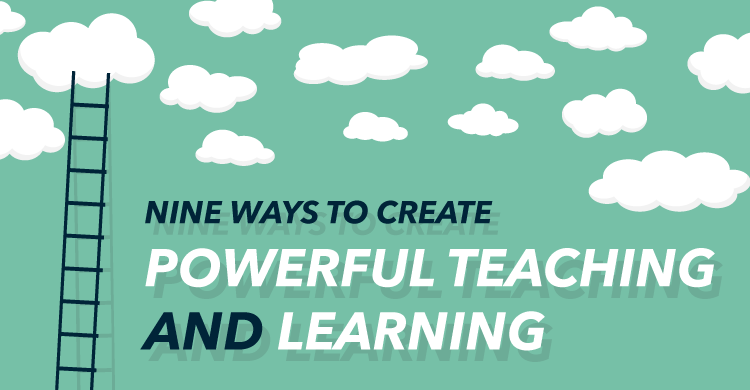Elliott Seif is the author of Teaching for Lifelong Learning: How to Prepare Students for a Changing World.
In my various roles in education, I have had direct teaching experience, conducted professional development with hundreds of preservice and practicing educators, and observed and had important discussions with teachers over many years. All these experiences have helped me learn a lot about powerful teaching and learning and what seems to work well for many teachers in many circumstances and situations.
My ideas and suggestions below, based on my many years of experience, will hopefully be helpful to educators and suggest ways to think about powerful teaching and learning. I have classified these suggestions into nine categories, and you may find the categories themselves helpful as a way of thinking about how to improve teaching and learning.
1. Humanize yourself and your students.
- Talk to your students about your own life, where you grew up, your college experience, why you decided to become a teacher, etc.
- Don’t stand too long in the front of the classroom. Make a conscious effort to continually walk around the room as you teach. When students are working on an exercise or activity, make it a point to see what students are doing and comment on their work.
- Provide opportunities for students to self-reflect. For example, frequently use activities that ask them to summarize and explain what they have learned, reflect on their interests and talents, and describe their goals for the future and their plans for getting there.
- One self-reflection exercise, called the Values Writing Activity, has been demonstrated to shrink the achievement gap among students. In one study, students who wrote about this for 15 minutes and didn’t even discuss it shrank the achievement gap by 40 percent! The activity is as follows: Have students write about their most important value or values. (What do you value the most and why? What are your most important values and why?) Share responses in pairs. Discuss as a large group. List values described by students on the board. Discuss whether the values include helping others, solving problems, dealing with injustices, etc. Discuss whether there are values that are missing. Put key values on a posterboard and post in the classroom to periodically remind the class what they value.
2. Explain, clarify, and focus goals and expectations.
- Discuss and create two to three positive core rules for the classroom and try to strictly enforce them (e.g., work hard, support your classmates, be a model for others). Praise students as they follow the rules. Come back to these periodically to discuss whether the rules are being followed, and, if not, why not.
- Try to focus on a few important understandings and skills at any one time. Explain your learning goals often—why they are important, and why they should be important to students (if you can’t figure out why it’s important to them, then don’t teach it!). You might tie your goals and expectations to learning more about the world around them, developing key, critical skills for living in a changing world, how meeting the goals will contribute to their success in life, how the learning goals will help them move ahead in school, or other reasons that resonate with your students.
- Break down key goals and expectations into smaller steps if possible. Help students figure out how they can learn these smaller steps to get to the larger goal.
3. Make learning more relevant and meaningful.
- Teach content around understanding and learning big ideas that put learning information into a meaningful context.
- Pick relevant, meaningful themes that also enable you to teach critical skills like research (including reading), thinking, and communication. For example, use more relevant writing assignments to teach essay, report, or persuasive writing, or more interesting reading materials to teach vocabulary and concepts. Many reading materials like this are freely available through the internet.
- Instead of behavioral goals or other ways of depicting goals that are hard for students to understand or identify with, start your units of study with essential, compelling, relevant questions that you develop out of your goals, or challenging problems or puzzles. Discuss these with students to introduce the unit.
- Find relevant, interesting resources and materials to use with students. If you need to, raise money on fundraising websites for these materials.
- Create more choices, such as giving students the opportunity to self-select books to read or opportunities to develop interest-based or passion projects.
- Use online and community-based resources where possible—videos and podcasts, interviews online and in person, and field trips. Introduce students to the Khan Academy, a website where they can independently watch videos that explain important concepts, ideas, and skills.
4. Feed the positive, starve the negative.
- Try to focus more on the positive aspects of your students and classroom. Concentrate a lot more of your energy on your students who want to learn, are doing their work, etc. Praise them for their effort and hard work, support them, use them as the model for what you expect from all. Make it a point to contact parents or guardians on a regular basis about good things that they do, hard work, good behavior, etc. When you can, work with parents or guardians to help them support your efforts and be helpful.
- Learn more about ways to encourage a growth mindset, such as praise for effort and a focus on improvement and feedback. This is a way to encourage students to do their work, see progress, seek to improve, and learn from errors.
5. Make yourself accessible to your students.
- Be a good listener to your students.
- Create office or after-school hours where students can ask for help on assignments or just come and talk.
6. Find help and support for students who most need it.
- If some of your students are dealing with traumatic situations and need outside help, find ways to help them. Refer students who need the most help to the counselor or to other available services.
7. Rethink instruction.
- Think of instruction in terms of four different phases: setting the stage, building a foundation, applying and deepening learning, and closure (completing work and sharing). How will you set the stage for learning and encourage curiosity and interest? Guide students so that they develop important skills and understandings? Help them to apply learning and work independently and more deeply? Complete their work at a high level and share it with others? Read more about this instructional approach in chapter two of my book Teaching for Lifelong Learning.
- Don’t teach directly to a standardized test. Teach the content and skills students need, but in an interesting and different way. For example, if students need essay-writing skills, there are many ways they can be taught through interesting assignments. The skills they learn can then be applied and translated into test questions.
- Expand your repertoire of teaching strategies. Find resources that suggest more ways to engage and involve students, give them supportive feedback, and so on. Many Solution Tree publications can help with this.
8. Have more fun with your students.
- Take some time during the week to do something different with your students—solve a puzzle, play a game, talk about their lives.
- If you are an elementary teacher, institute a time during the week, such as “game time,” when students are given game options—Scrabble, chess, checkers, etc.
- Periodically give students a chance to share, reflect on, and discuss what they have learned, their goals, their interests, their hobbies, and so on.
Finally, the ninth suggestion, find allies and build a support system, is a way to build a learning community to help implement the previous eight suggestions, and more. The goal is to find allies in a school, a district, or other educational communities (such as online) to form a team to learn from each other and to try new things, such as how to make learning more relevant to students or how to feed the positive and starve the negative. Small groups might work informally, but also set up formal times to discuss specific teaching situations and student problem situations in order to determine how to handle them more effectively. Members of support teams can find new resources to share—and act as resources to each other—to help solve teaching problems, make teaching more interesting and effective, and better implement the other eight suggestions in this post.






